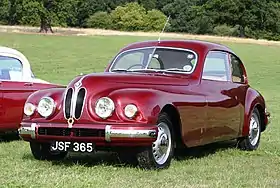Bristol 401
The Bristol 401 saloon and Bristol 402 cabriolet are British luxury sporting cars, produced between 1948 and 1953 by Bristol Cars, an offshoot of the Bristol Aeroplane Co..[2] They were developed from the Bristol 400, which continued in production alongside the 401 and 402 until 1950.
| Bristol 401 Bristol 402 | |
|---|---|
 Bristol 401 | |
| Overview | |
| Manufacturer | Bristol Cars (then Bristol Aeroplane Co.) |
| Production | 1948–1953 (401) 1949–1950 (402) 611 Bristol 401 units 23 Bristol 402 units |
| Body and chassis | |
| Class | Sports sedan Convertible |
| Body style | 2 door coupe 2 door convertible |
| Layout | FR layout |
| Powertrain | |
| Engine | 1971 cc ohv straight-6 |
| Transmission | 4-speed manual |
| Dimensions | |
| Wheelbase | 114 in (2,896 mm)[1] |
| Length | 191.5 in (4,864 mm)[1] |
| Width | 67 in (1,702 mm)[1] |
| Height | 60 in (1,524 mm)[1] |
| Chronology | |
| Predecessor | Bristol 400 |
| Successor | Bristol 403 |
Although mechanically the 401 and 402 used an improved version of the BMW M328 hemi-head engine and its unusual arrangement of two separate pushrods to operate the exhaust valves (necessitated by the hemispherical combustion chambers and opposite facing valves) used in the 400, the styling was a huge advance on the pre-war bodies of that first Bristol model. It was inspired by the Milanese designer, Carrozzeria Touring, and its most notable feature was that the door handles were not exposed and to open the doors the owner pressed a button into a groove in the door. The body also was more spacious than the 400 and was a full five-seater.
At the front the 401 and 402 were also quite distinctive with their headlights moved quite a distance into the centre of the body on either side of the narrow grille, which resembled BMW a little less than did the 400. They were also deeply curved at the front: this, along with the then-unique door handle arrangement, is believed to give the 401 a drag coefficient of less than Cd 0.36 — competitive even by today's standards and remarkable for the time.
The engine was the same 2-litre in-line six-cylinder petrol unit of the 400, but was upgraded through improved Solex carburettors to increase power by 5 bhp (3.7 kW) to 85 bhp (63 kW), which improved the performance further beyond what was achieved by the aerodynamics.
The suspension is independent at the front using a transverse leaf spring and wishbones and the rigid axle at the rear uses torsion bars. Steering is by rack and pinion. The brakes are Lockheed hydraulic with 11 in (279 mm) inch drums all round.
Although the 401's production figure of 611 is still the largest of any Bristol model, the 402 is regarded as one of the rarest classics among cars of its day. In a recent survey, 13 of the 23 produced could be accounted for.
A saloon tested by The Motor magazine in 1952 had a top speed of 97.3 mph (156.6 km/h) and could accelerate from 0-60 mph (97 km/h) in 15.1 seconds. A fuel consumption of 20.8 miles per imperial gallon (13.6 L/100 km; 17.3 mpg‑US) was recorded. The test car cost £3532 including taxes.[1] Referring that road test in a subsequent ‘classic car’ feature, the journal summarised the 401 as a “Medium-sized car offering very high standards of comfort and performance”.[3]
.jpg.webp) 401 Touring Superleggera (1949)
401 Touring Superleggera (1949).jpg.webp) Rear view of the Superleggera
Rear view of the Superleggera.jpg.webp) Rear view of a 1950-52 401
Rear view of a 1950-52 401 Bristol 401 with bonnet open
Bristol 401 with bonnet open.jpg.webp) 402 dashboard
402 dashboard Bristol 402
Bristol 402 Painting of the Bristol 402
Painting of the Bristol 402 Aerodynamic shape of Bristol 401
Aerodynamic shape of Bristol 401 1951 Bristol 401 with 2L 85C BMW derived engine adapted by Bristol
1951 Bristol 401 with 2L 85C BMW derived engine adapted by Bristol
References
External links
| Wikimedia Commons has media related to Bristol 401. |
- Bristol Owners Club - Bristol Type 401 - 2 litre Saloon
- Bristol Owners Club - Bristol Type 402 - 2 litre Drophead Coupe
